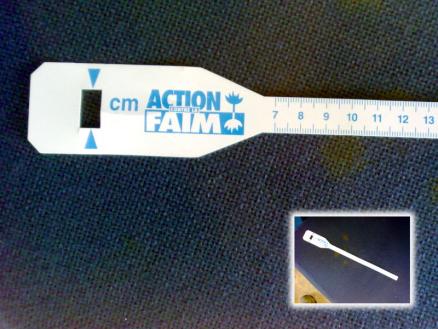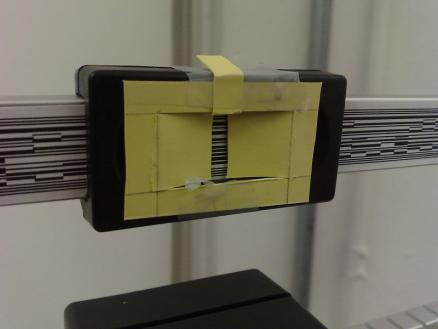Breakthrough
So, I had a good day at the Martin Preuss clinic with the programmers from Baobab. We went for them to interview the stakeholders of the system they've put in place at this combined HIV and outpatient TB center. That was very interesting and gave me some great insights into how the system functions overall.
Then we stopped by the office of one of the nurses, Jane, and Mike McKay helped me out by asking some questions about how Mid-Upper Arm Circumference is tested and why. Some results:
MUAC is measured in the HIV/AIDS clinic on:
- Pregnant Women
- Lactating Women
- Children 1 to 5 years old
The MUAC determines the nutrition status.
For children 1 to 5 the ranges are:
- At risk: 12 to 13.5 cm
- Moderate: 11 to 11.9 cm
- Severe: less than 11 cm
For pregnant or lactating women:
- At risk: 22 to 23 cm
- Moderate: 19 to 21.9 cm
- Severe: less than 19 cm
These patients have their MUAC taken every time they come in.
We then went to the vitals station to see how this was measured. The band used has markings between 7 and 30.5 cm.
 MUAC Strip from Martin Preuss Clinic
MUAC Strip from Martin Preuss Clinic
There is only one of these and it is made of flexible plastic, maybe 5 mil or slightly more in thickness.
At the station, I found:
- A balance scale and stadiometer very much like that in the lab at home (Detecto brand)
- A Baobab touchscreen terminal
- A bar-code scanner
- The MUAC strip
- Detergent dish soap
- Bleach
- Cotton swabs
This leads me to three tentative assumptions:
- The strip is permanent and is regularly cleaned and disinfected
- The vitals station consists of most of what I wanted to include in the system already--the bar-code scanner is already there with the terminal!
- I missed the memo on the length of the band, but it can be changed without much hardship
I am going to try and sit in on a clinician taking these measurements over the next few days and actually watch the station at work. If I can get good observations of the movements and timings involved, I could use that data as a baseline to judge the new work.
I guess you could say today was a good day.
- Mike's blog
- Comments
- Read more



- 4557 reads
Back in Malawi
I'm back in the warm heart of Africa as of two days ago. After recovering from the trip yesterday (which was a national holiday, too) I'm in the Baobab offices fooling with some of the newer ScanBand prototypes.
Since I'll only have Wi-Fi part of the time, my main blogging channel will again be twitter, the feed for which will shown at the top of the homepage until I get back.
Pretty interesting stuff going down here right now. Just an hour or two before I landed, Malawi dropped ties with Taiwan in favor of China. In the long run, it looks like the best financial situation for Malawi, which could receive $6 billion in aid (as opposed to a relatively much smaller amount from Taiwan). In the near term, though, the Taiwanese are pulling out fast, and that could leave clinics run by them in serious disarray until everything stabilizes. This will be a very difficult situation in the next weeks and months for the health-care sector.
Anyway, I'm staying as a guest in an awesome house here. My roommate is William Kamkwamba, known widely for his homemade windmill. He just got back from the US, too, and started school this morning. Wish him good luck!
That's the scoop for now. It's going to be a very busy 10 days, but I'm very glad and very grateful to be back here.
- Mike's blog
- Comments



- 4658 reads
Demonstrating the ScanBand
Tracy generously volunteered to be my patient for the demonstration of the ScanBand arm and waist prototype during my thesis presentation for the end of this semester:
- Mike's blog
- Comments



- 4227 reads
ScaleBand Version Zero
 Fine Weight Adjustment with ScaleBand
Fine Weight Adjustment with ScaleBand
For my next trick, I'm modifying a SECA 800 medical scale with a SECA 220 height bar attachment. The measuring surfaces of the scale and bar will be covered or pegged to a scannable strip that represents the specific axis of measurement. I am going to encode the data of the fine and gross weight adjustments, as well as the height bar, so that the measurements coming off of the bar are unique. That way, the receiving system will not confuse a measurement taken from the fine weight measure with a gross weight or height measure.
- Mike's blog
- Comments
- Read more



- 5544 reads
Fall 2007 Thesis Midterm Presentation
The thesis midterm went well, with great criticism from Marko, Sven, and Ted. I have attached my thesis presentation below as a PDF for all to enjoy.
Lots of work left to do, though. Hopefully, I'll be cranking out a new prototype, for straight linear measurements, within the week. It could be used for anything from height measurement to blood pressure.
- Mike's blog
- Comments



- 3169 reads
Thesis Abstract, Fall Midterm
Right now, in Malawi, there is a need to bring patients' physical measurements into accurate, long-term records. My idea is to channel these measurements into their system digitally. Through a suite of simple technologies, I will enable technicians to record arm, waist, hip, and head circumference quickly and reliably. These data will then feed directly into a database via Baobab's thin-client terminal appliances. By doing this, fewer errors in measurement and transcription will arise. Health care providers will have access to cumulative, permanent patient histories.
Patients' physical measurements will be read via a device called ScanBand. ScanBand consists of a thin strip of paper or flexible plastic, the majority of which is covered with a series of bar codes. Each bar code is printed with a specific height, such as 5 mm, and encodes length of the strip from the bar code itself to a cutout “window” at the end of the strip. By making a loop with the paper, technicians with a ScanBand can rapidly and accurately measure the circumference of several parts of the patient’s body.
My methodology thus far has been twofold. I am producing a series of working prototypes, in quick succession, and testing them on subjects to evaluate their ease of use, accuracy, and overall look and feel. I am also discussing these prototypes with stakeholders and other interested parties in Malawi and the United States. With each revision, I have taken this test data and applied the lessons learned to a new version of the ScanBand. As an integral part of this thesis, I am also preparing more rigorous evaluation tools that will be given to testers of the ScanBand to determine their overall level of satisfaction with versions of the band I create throughout this project.
- Comments



- 5246 reads
CC Lecture Presentation and Sydewynder 0.1.1
I presented an overview of the Sydewynder application to Sven Travis's Creativity and Computation lecture class today. I've attached the PowerPoint and PDF below (and an OpenDocument presentation can be posted, if anybody wants that).
Also, I've released Sydewynder 0.1.1, which has the option to take screenshots of the apps as they run (useful for putting together the presentation) and a new "Round Robin" sample app that shows how to send a single SMS messages to multiple recipients and multiple messages to several recipient lists.
- Mike's blog
- Comments



- 5957 reads
Sydewynder 0.1 Is Loose!
The latest version of Sydewynder, our mobile application server for the S60, has been released! With Sydewynder, any S60 phone, like the Nokia N80, can become an automated SMS gateway. You can grab version 0.1 off of the SourceForge site.
This new version features:
- scripts can now connect to WiFi, making Internet-enabled responses possible!
- emulator for off-phone development. Now students don't need to have a phone to develop mobile apps for it
- two tabbed pane view for logging and status indicators
- start up screen -- very pretty!
- a much better UI
- a new example application using WiFi - "We Feel Fine". It taps into the wefeelfine.org API
And these bugs were fixed:
- recipients in the address book could not receive text message responses
- unicode text problems
Much thanks for Sven, Colleen, Chuck, Eric, Albert, and Chloe for their support, ideas, and code.
- Mike's blog
- Comments



- 4846 reads
Neighborhood Type
Kitsch causes two tears to flow in quick succession. The first tear says: How nice to see children running on the grass! The second tear says: How nice to be moved, together with all mankind, by children running on the grass! It is the second tear that makes kitsch kitsch.
-Milan Kundera
I was assigned to go into a NYC neighborhood and document what I noticed about the type. What I found, in Chelsea and Hell's Kitchen, was a lot of kitsch, in Kundera's sense of the word. So much of the type in the newest presentations refers back to old industrial or distressed type, but in a way that is knowing and safe. It simultaneously induces a frisson from the decayed and supposedly dangerous in a New York working-class neighborhood, while letting the observer in on the joke.
To reformulate the quote above, the two tears are how nice to be in a tough NYC neighborhood and then how nice to know, together with all mankind, that we are in a tough NYC neighborhood.
- Mike's blog
- Comments



- 4167 reads
ScanBand v0.5 -- Now With Less Width!
This is the newest version of the ScanBand series of arm-measuring devices. This time around, I've made it as narrow as I think it can possibly get. The measuring numbers were turned 90 degrees and laid out side-by-side along the edge. The bar codes are the same size as version 0.4, but I think this is as small as I can make them while still allowing for them to be scanned.
Attached is the zip with the PDF and the SVG file. It's made available under the Creative Commons Attribution ShareAlike License version 3.0, copyright 2007 Mike Edwards and Baobab Health Partnership.
- Mike's blog
- Comments



- 3122 reads
tags
Copyright Mike Edwards 2006-2009. All content available under the Creative Commons Attribution ShareAlike license, unless otherwise noted.
